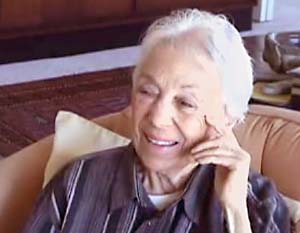 Bebe Barron June 16, 1926 -- April 20, 2008 |
A
pioneer, kindred
spirit and significant inspiration for many of us, Bebe was
an older "potential" friend whom I never met. She lived and
worked with her then husband, Louis, not very far from where
I've lived and worked for a large part of my life. Alas, she
relocated to California just around the time I arrived in
New York City from RI, to begin my graduate work in
composition and electronic music at Columbia. We nearly DID
meet later on, several times in fact, through mutual friends
who claimed we'd get along well together. But that was not
to be, including a couple of final "on-again / off-again"
get-together plans that lingered along for two years, before
being abandoned for health reasons.
(Special
thanx to Pete Grenader, who especially attempted to
bring this to happen.)  When
I think about it, the Barrons' score
(dubbed
"Electronic Tonalities" in the film's on-screen credits by a
clever Schary, trying to hold off complaints from both
musicians' and engineers' unions for this new hybrid
methodology) was among
the very first examples of electro-acoustic music I ever
heard. (RCA had released their 1955 demonstration LP of the
Mark I RCA Music Synthesizer, just the year before, when I
stumbled upon it, one of my first ever record album
purchases "in my yoot".) It jolted me into attention that
this might be a wonderful field to dedicate myself to
eventually. It was many years later before I heard their
collaborative work with Anaïs Nin and John Cage
("Williams
Mix"), besides their
own independent compositions. Some statistics: There's a closing thought I'd like to share with you. Bebe was pleasantly surprised that her final (computer based) music sounded so consistent with the earliest music created in the 8th street studio, which proves that it's the composer's ear that matters most, less so the technology and tools used. Her solo works and filmscores, not easy to find (aside from the FP soundtrack), are worth the effort to track down. At least there's quite a bit of information on the Bebe and Louis (who died in 1989) to be found online -- I'll add a few links below, which currently are active. Quality can't be measured (mindlessly) in mere dollars, something most of us seem to have lost sight of, overlooking the humanity and craft behind every fine artist. In the next section below, we'll look at some photos with texts about Bebe. Meanwhile, here are several currently available biographical links: HERE, HERE, HERE, and a few obits HERE, HERE, and HERE. (Composer Barry Schrader, a close friend of Bebe's for years, contributed his personal memories and a thoughtful eulogy online, which is quoted and excerpted in many of the obituaries. Special thanks also to Leonard Neubauer, Bebe's second husband and a respected, creative writer, for his thoughtful communications with me around the time of Bebe's death.)
|
|
It was a matter of great serendipity that I learned the address of the Barron's NYC apartment early this year, from a mutual friend, Pete Grenader, who now manufactures one of the finest lines of retro and completely new creative analog synthesis modules, under his company name, Plan B, which is based in Los Angeles. I "met" Pete via e-mail just around the time SEAMUS wanted to present me their award (he's was among those who talked me into accepting it), and we've still to have a real f2f visit, although we stay in frequent touch via technology. He'd been a close friend of Bebe's, one of the last people in the EAMusic field to visit with her before her untimely death. (Pete's description of the way they sat facing each other, chatting away, with her gripping his hand so earnestly, is an image I'll not soon forget.) 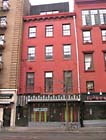 (click for larger view) When
it became obvious that Bebe's health was failing to such an
extent that a long planned return visit to New York would
probably never now take place, I "plotted" to share at least
a small vicarious look-see with her and her writer husband,
Leonard, of what the old building now looked like. So on the
next non-marrow-freezing
morning (yeah, we had a cold winter this year), I grabbed my
small digital camera and set off to find it.  (click for larger view) Few people were out walking that early morning, and no one bothered, or even noticed me. After taking a few overview shots from the other side of the street, I crossed back to inspect the entranceway. Here's the front door, a nondescript charcoal-brown painted steel door. Looks pretty secure. The thoughts of the Barrons using that door each day, many creative other people from the 50s passing through to visit and collaborate, half a century ago, filled my thoughts: Nin, Schary, Cage... and others who collaborated with Louis and Bebe, in their home-built, pioneering recording studio. 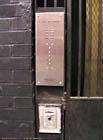 (click for larger view) The entrance buzzers look relatively new, mounted on an engraved stainless steel plate. I wonder what was there in the mid 50s? If this were France, England, Germany or another such country which instinctively values its creative artists, there would be a small plaque located somewhere here to mark what surely is the most important page of musical history for 9 West 8th. I recall seeing such a plate on the entrance to the door to the apartment in Paris in which Ravel composed his score to Daphnis and Chloe. This door bears no such encomium. 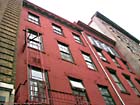 (click for larger view) Step back a few feet, then turn and look up, and you'll see the way the building looks some 50 years since it housed that historical studio. I wonder what color it was when the Barrons lived and worked here? When Bebe saw these same photos, she sent a kind message back to me to thank me, but didn't allude to the color (nor give me the floor or apartment number I asked about). So I guess it's even possible that the Hermiston or Brick Red shade might date back to their years, just repainted a couple of times since then. From this and the sat photos on Google, you can see that it's a small apartment house, like many in this neighborhood, perhaps 20' wide, and not much more than 60' deep. The rooms inside would be less than half that size, front and rear on each floor. My own first studio was in a room of similar size. It can be a challenge, but there are many even smaller private studios in use around the globe. (Of course our circuitry is FAR more compact -- this was all bulky, heavy, hot, tube gear!) 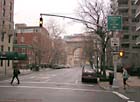 (click for larger view) I
thought Bebe would enjoy a glance of the large arch at the
entrance to Washington Square Park, just down the block, as
appears today, and took this final photo as I started back
home. This is the corner of Fifth Avenue (which begins at
the Arch) and 8th Street, facing South. See, not many people
out in the chilly, spitty, sullen weather, although most
days and evenings this neighborhood "features" high
pedestrian and street traffic (and growing worse with each
passing year). 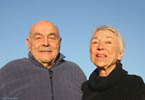 (click for larger view) Bonus
Photo- I'd like to
thank Susan Stone, who interviewed (and became friends with)
Bebe as part of a definitive 2005 NPR "Morning Edition", for
allowing us to share this recent lovely photo she took of
Leonard and Bebe. It originally appeared in
conjunction with that excellent
interview,
conducted at Bebe's home in CA. I loved the photo when I
first saw it in a smaller online version, and it makes the
perfect ending to this selection of photos -- a charming way
to remember Bebe...
--Wendy Carlos, New York City, July 2008 © Photographs Copyright 2008 Wendy Carlos and Serendip LLC. |
On Bebe
Barron
©
2008 Serendip LLC. No images, text, graphics or design
may be reproduced without permission. All Rights
Reserved.
![]()